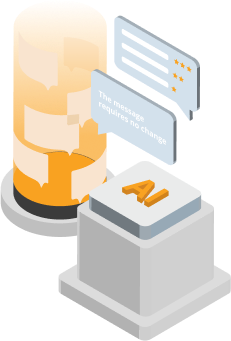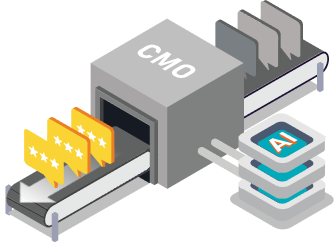 Blog posts
Blog posts
Can innovation in market research lead to winning messaging campaigns?
 Newristics
Newristics
 06 May 2022
06 May 2022
 Back
Back
 Newristics
Newristics
 06 May 2022
06 May 2022

Over the past decade, there has been a lot of innovation in the market research industry, changing the way insights professionals capture and report insights today. The industry has responded to the universal client need for making market research projects faster, cheaper and better.
DIY Survey Platforms – Market research surveys used to take weeks to develop/finalize and
several more weeks to program for fielding. Survey programming required specialized software
platforms like Confirmit, Sawtooth, etc. and could only be programmed by survey fieldwork
experts.
Today, market research can be conducted through microsurveys that can be
programmed directly by anyone on the insights team. Cloud-based customer feedback and
intelligence platforms are making it easier for insights teams to test ideas, capture
shopper behaviors, evaluate brand health, understand barriers to purchasing, and more.
First party customer databases – Historically, respondents for market research studies were recruited only through third party panel providers. In an attempt to get better respondent feedback while simultaneously also reducing panel costs, most large brands are now building first party customer databases of their own. By engaging customers (past or present) in short, intuitive surveys, brand teams can get higher quality feedback and insights from surveys.
Behavioral Science – Insights teams are replacing “stated” research techniques with
behavioral science inspired methodologies to get more human insights from research.
Behavioral science is a 3-time Nobel Prize winning field of research that has shed light on
how humans make decisions using mental shortcuts like heuristics and
biases.
Insights teams have embraced the use of behavioral science in research
and are now accepting the fact that customers don’t DO what they SAY and often they don’t
even say what they THINK or FEEL. Behavioral science helps bridge the gaps between
FEEL/THINK/SAY/DO and helps brands teams get deeper, more actionable insights from every
research project.
Data reporting and visualization – For decades, survey findings from market research projects
were delivered through Powerpoint decks filled with boring bar charts and cross- tables.
Innovation in data visualization technologies has made a big impact on how insights from
market research studies are reported and shared within brand teams.
Real-time
reporting of research data is also changing how brand teams act upon research findings. In
the past, teams had to at least wait for the preliminary read out presentation, which took
weeks to prepare from the last day of fieldwork. Today, real- time reporting of survey data
through online dashboards makes it possible for insights teams to intervene early in
research projects and get the right questions in the survey based on early data.
Despite all the innovation seen in market research over the past decade, one type of market research that is still operating in the old model is message testing research. There has been little methodological innovation in message testing and standard survey methodologies conventionally used for message testing still don’t meet some basic needs of brand teams:

With increasing use of digital marketing channels, message testing has also been shifting out of market research/insights teams to marketing teams because they are conducting in-market A/B testing as part of their marketing campaigns. While A/B testing is easy to conduct and uses real- world results, data shows that 80% of A/B tests don't produce any results and are canceled before they reach statistical significance.
A/B testing has many of the same constraints that market research-based message testing has. Most brand teams can only afford (time and money) to test a few (6-8) messages in A/B tests. A/B tests don’t explain why one option is better than the other and attribution analysis is difficult if the A/B tests are run on bundles of messages instead of single messages like email subject lines.
Message testing research needs a reboot. Currently, it is not helping insights teams deliver what their marketing partners really need to execute winning messaging campaigns:

An ideal message testing system would require a fundamentally different methodological
approach that uses science and algorithms to test more messages in market research and
produces deliverables that directly lead to messaging campaigns.
Decision heuristics science can transform how messages are tested in surveys with respondents:
Artificial Intelligence can transform how data from message testing surveys is used to drive campaigns:
CMO (Choose Message Optimizer) from Newristics combines the power of decision heuristics science and AI to test messages in a better way. CMO has been proven superior in industries with the most complex messaging needs, like the pharmaceutical industry. In a meta-analysis of 50+ studies in the pharmaceutical industry, CMO was consistently proven to be superior:

To demonstrate the value of innovation in message testing in the banking industry, Newristics conducted a large-scale, head-to-head, challenger type study using control messages from the #1 bank in the country - JP Morgan Chase. The study was designed to be the ultimate messaging challenge:
Can a different approach to developing and testing messages outperform the messaging efficacy of the country's largest bank...without the help of their marketing department?
Process
Results
So, how was the bank messaging improved by 30-50%?
Since customer acquisition in banking is driven mostly by trigger events (e.g. moving to a new city), banks need an always-on messaging model so that they can be in the consideration set whenever a consumer is ready to switch. Being always-on is an expensive value proposition in messaging and can be cost prohibitive unless the messaging playbook is optimized for segment-level and channel-level messaging.
Retail banks have the opportunity to make their messaging campaigns significantly more effective
by utilizing decision heuristics science + AI in the development and testing of messaging before
the campaign launch.
Download the full study report here
and get up to speed on the
latest scientific and algorithmic advances in messaging optimization.
About Newristics Newristics is famous for helping brands optimize messaging using a combination of behavioral science and machine learning algorithms. In the past ten years, Newristics has optimized messaging for 100s of world-leading brands generating $100s billion in revenue every year.